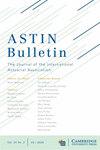A GROUP REGULARISATION APPROACH FOR CONSTRUCTING GENERALISED AGE-PERIOD-COHORT MORTALITY PROJECTION MODELS
IF 1.8
3区 经济学
Q2 ECONOMICS
引用次数: 3
Abstract
Abstract Given the rapid reductions in human mortality observed over recent decades and the uncertainty associated with their future evolution, there have been a large number of mortality projection models proposed by actuaries and demographers in recent years. Many of these, however, suffer from being overly complex, thereby producing spurious forecasts, particularly over long horizons and for small, noisy data sets. In this paper, we exploit statistical learning tools, namely group regularisation and cross-validation, to provide a robust framework to construct discrete-time mortality models by automatically selecting the most appropriate functions to best describe and forecast particular data sets. Most importantly, this approach produces bespoke models using a trade-off between complexity (to draw as much insight as possible from limited data sets) and parsimony (to prevent over-fitting to noise), with this trade-off designed to have specific regard to the forecasting horizon of interest. This is illustrated using both empirical data from the Human Mortality Database and simulated data, using code that has been made available within a user-friendly open-source R package StMoMo.构建广义年龄-时期-队列死亡率预测模型的群体正则化方法
鉴于近几十年来观察到的人类死亡率的快速下降及其未来演变的不确定性,近年来精算师和人口学家提出了大量的死亡率预测模型。然而,其中许多预测都过于复杂,从而产生了虚假的预测,特别是在长期和小而嘈杂的数据集方面。在本文中,我们利用统计学习工具,即群体正则化和交叉验证,通过自动选择最合适的函数来最好地描述和预测特定数据集,为构建离散时间死亡率模型提供了一个强大的框架。最重要的是,这种方法在复杂性(从有限的数据集中获取尽可能多的洞察力)和简约性(防止过度拟合噪声)之间进行权衡,产生定制模型,这种权衡被设计为对感兴趣的预测范围有特定的考虑。这是使用人类死亡率数据库的经验数据和模拟数据来说明的,使用了用户友好的开源R包StMoMo中提供的代码。
本文章由计算机程序翻译,如有差异,请以英文原文为准。
求助全文
约1分钟内获得全文
求助全文
来源期刊

ASTIN Bulletin
数学-数学跨学科应用
CiteScore
3.20
自引率
5.30%
发文量
24
审稿时长
>12 weeks
期刊介绍:
ASTIN Bulletin publishes papers that are relevant to any branch of actuarial science and insurance mathematics. Its papers are quantitative and scientific in nature, and draw on theory and methods developed in any branch of the mathematical sciences including actuarial mathematics, statistics, probability, financial mathematics and econometrics.
 求助内容:
求助内容: 应助结果提醒方式:
应助结果提醒方式:


